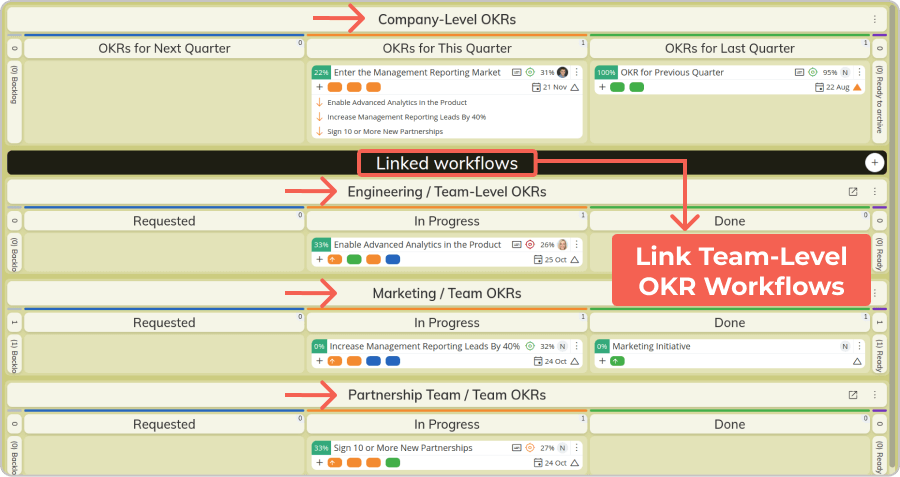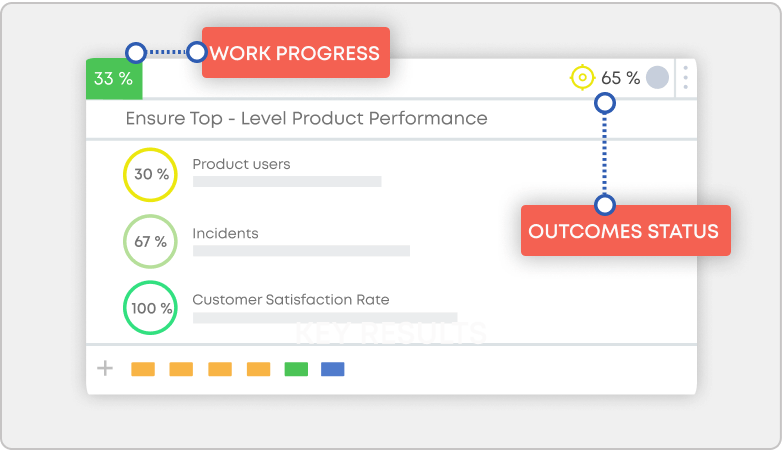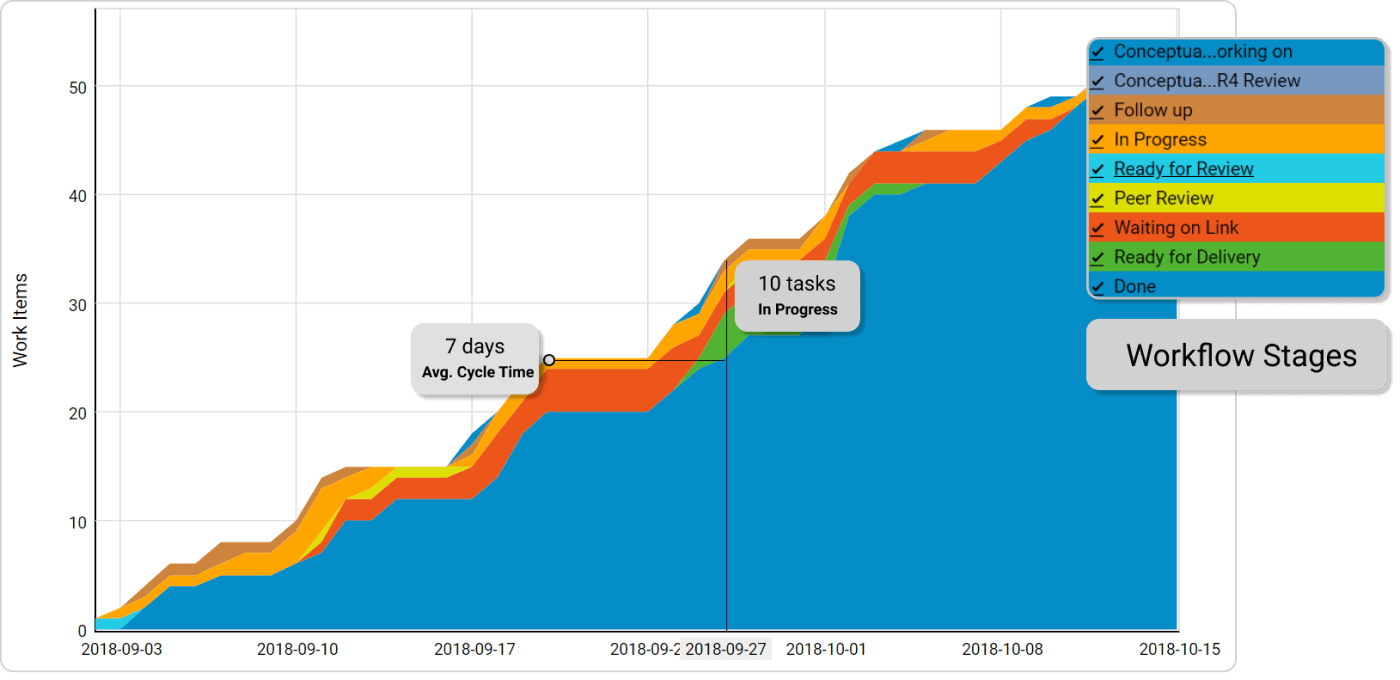What Is OKR Reporting?
OKR is a goal-setting framework that helps organizations set ambitious goals and connect strategy with execution. Setting OKRs on a team or global level at the organization can help ensure that all efforts are directed toward a common goal.
Reporting on your OKRs allows you to review your outcomes and understand if you’ve set the right ones to help you move toward your strategy. Moreover, it facilitates transparency and improves decision-making based on actual data.
It’s important to regularly review and report on your OKRs on a team and strategic level as a way to monitor progress, adapt to changes when necessary, and improve in the long run. Tracking OKRs and regularly reviewing previous events will also help you boost people’s understanding of the main priorities and alignment with the company’s vision.
Let's look at the benefits of OKR reporting practices more closely.
Decision-Making Based on Actual Data
One of the most underlined and praised characteristics of OKRs is their measurability. The raw data behind the execution of each objective is one of the reasons behind the popularity of the goal-management framework.
There might be a case where you have a very long-term objective that would take 3 years to complete but remember that it's not recommended to wait that long to get any data about your goal. Reducing the size of your measurements, reporting, and getting a quick turnaround on them will help you accumulate important insights. The idea is to shorten the time for which you measure the results, so you can adapt to changes early and ultimately become more agile.
Improved Customer Focus
Besides relying on accurate data, regularly reporting on OKRs contributes to continuously bringing the focus back to the customer. With today’s dynamic development and spiraling demands, shifting priorities is the new norm that businesses must adhere to. Frequent check-ins about the progress of key results can guarantee your actions are compliant with your organizational vision and your customers’ expectations.
Real-Time Progress Monitoring
OKR tracking and reporting ensure you have a clear picture of your goals' progress. Visualizing your objectives and key results can help you answer critical questions such as “What is the status of our goals?” or “Are we working on the right things to achieve them?”.
A transparent view of OKRs from where you can monitor and derive reports about the real-time progress of both organizational and team OKRs is oftentimes what C-level management really needs. This enhances alignment between strategy and execution while allowing managers to ensure teams are focusing on the right business priorities.
 Connecting company and team/department OKRs using Linked Workflows
Connecting company and team/department OKRs using Linked Workflows
Better Accountability
Reporting on OKRs also provides transparency about the teams that succeeded in achieving their goals and those that fell short. Assessing this information can lead you to various conclusions. One of them might be that your goals were too ambitious to achieve within a defined time frame which could mean that you should focus on shorter-term objectives instead.
How Two of The Largest Organizations in the World Save Time & Money with OKRs?
OKR Reporting Best Practices
To benefit from OKR reports in the above-mentioned ways and get results, here are a few practices you can employ while working with the goal-setting framework.
-
Make OKRs a part of your regular review meetings. This way, everyone will be on the same page about the progress made so far, plus, goals and their measurements won’t be forgotten.
-
Define easy-to-measure key results. Objectives in OKRs should be achievable and measurable, so it’s important to set realistic success criteria or key results upfront. Your Key Results should describe what success looks like for you in a very clear and unambiguous language.
-
Reflect on what was done to continuously improve. Regardless of the review cycle you use, OKRs should help you drive improvement forward. This could mean better collaboration, faster delivery, greater quality, etc. What’s important is to act upon what you have learned while reflecting on your OKRs.
-
Track results when needed. Although OKRs are often set quarterly, observations about the level of accomplishment or lack thereof are welcomed at any point in time. You can use your weekly or daily update meetings to tackle a certain key result without waiting until the mid-year or quarterly OKR review.
-
Use OKR software that supports tracking and reflecting on goals. A digital solution offers you an overview of the progress of OKRs, and their continuous alignment with your organizational strategy, in a single view. Real-time updates, progress indicators, and color features can further improve how you visualize and track your OKRs’ progress.
 Objectives and key results progress indicators
Objectives and key results progress indicators
How KPIs and OKRs Reporting Can Be Complementary?
OKRs and KPIs often portray the importance of measuring business success. While the two approaches help us understand the level of our performance, they should be used for different reasons.
While KPIs are more direct indicators of the level of performance, they don’t convey the sense of organizational direction that OKRs bring. KPIs may sound like serving the same purpose as Key Results; however, KPIs should be perceived as lagging health indicators that are more within reach and determine the current business performance. While KRs describe where you are aiming and should be regarded as leading indicators.
Tracking and regularly reporting on OKRs and KPIs will ensure you're moving forward toward your strategic direction while not losing sight of the ongoing health indicators for the business.
How Can Kanban Help Your OKR Reporting?
Through key practices such as workflow visualization, limiting work in progress, and establishing feedback loops, the Kanban method creates favorable conditions for OKRs to flourish.
One of the key advantages of Kanban is the flow metrics it employs to measure process efficiency and incorporate those insights into improvement opportunities. While different Kanban measurements can help you optimize your workflows (and eventually output), OKRs are a complementary lightweight layer to connect the outputs with the desired outcomes.
This is where Kanban metrics such as cycle time can contribute to better OKRs reporting. Measuring how long it takes you to deliver work helps you enhance process efficiency and, therefore, improve output. Eventually, if you're focusing/working on the right things, improving your output rates can increase the likelihood of achieving your goals/outcomes.
 Analyzing how your process "flows" on a Cumulative Flow Diagram
Analyzing how your process "flows" on a Cumulative Flow Diagram
Businessmap is the most flexible software
to align work with company goals
In Summary
OKR reporting refers to the practice of reviewing goals, assessing their progress completion, and providing constructive improvement feedback. Regular OKR reports can help you:
- Monitor your goals’ progress in real-time
- Incorporate higher agility to meet customers’ expectations
- Enable decisions based on actual data
- Achieve greater visibility into the priorities at hand





 Connecting company and team/department OKRs using Linked Workflows
Connecting company and team/department OKRs using Linked Workflows
 Objectives and key results progress indicators
Objectives and key results progress indicators Analyzing how your process "flows" on a Cumulative Flow Diagram
Analyzing how your process "flows" on a Cumulative Flow Diagram

